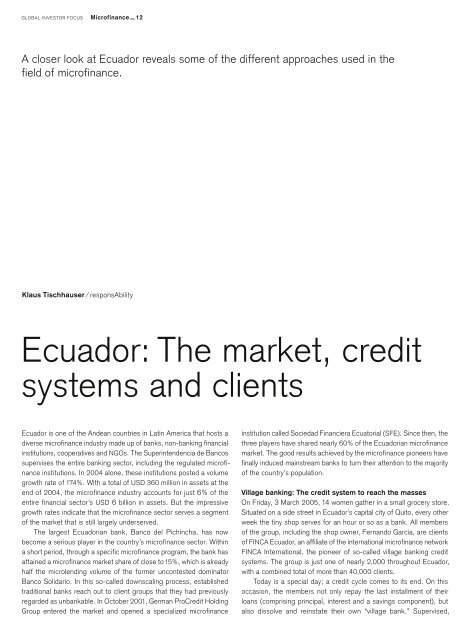Microfinance
Global Investor Focus, 02/20065 Credit Suisse
Global Investor Focus, 02/20065
Credit Suisse
Create successful ePaper yourself
Turn your PDF publications into a flip-book with our unique Google optimized e-Paper software.
GLOBAL INVESTOR FOCUS<br />
<strong>Microfinance</strong>—12<br />
A closer look at Ecuador reveals some of the different approaches used in the<br />
field of microfinance.<br />
Klaus Tischhauser ⁄ responsAbility<br />
Ecuador: The market, credit<br />
systems and clients<br />
Ecuador is one of the Andean countries in Latin America that hosts a<br />
diverse microfinance industry made up of banks, non-banking financial<br />
institutions, cooperatives and NGOs. The Superintendencia de Bancos<br />
supervises the entire banking sector, including the regulated microfinance<br />
institutions. In 2004 alone, these institutions posted a volume<br />
growth rate of 174%. With a total of USD 360 million in assets at the<br />
end of 2004, the microfinance industry accounts for just 6% of the<br />
entire financial sector’s USD 6 billion in assets. But the impressive<br />
growth rates indicate that the microfinance sector serves a segment<br />
of the market that is still largely underserved.<br />
The largest Ecuadorian bank, Banco del Pichincha, has now<br />
become a serious player in the country’s microfinance sector. Within<br />
a short period, through a specific microfinance program, the bank has<br />
attained a microfinance market share of close to 15%, which is already<br />
half the microlending volume of the former uncontested dominator<br />
Banco Solidario. In this so-called downscaling process, established<br />
traditional banks reach out to client groups that they had previously<br />
regarded as unbankable. In October 2001, German ProCredit Holding<br />
Group entered the market and opened a specialized microfinance<br />
institution called Sociedad Financiera Ecuatorial (SFE). Since then, the<br />
three players have shared nearly 60% of the Ecuadorian microfinance<br />
market. The good results achieved by the microfinance pioneers have<br />
finally induced mainstream banks to turn their attention to the majority<br />
of the country’s population.<br />
Village banking: The credit system to reach the masses<br />
On Friday, 3 March 2005, 14 women gather in a small grocery store.<br />
Situated on a side street in Ecuador’s capital city of Quito, every other<br />
week the tiny shop serves for an hour or so as a bank. All members<br />
of the group, including the shop owner, Fernando Garcia, are clients<br />
of FINCA Ecuador, an affiliate of the international microfinance network<br />
FINCA International, the pioneer of so-called village banking credit<br />
systems. The group is just one of nearly 2,000 throughout Ecuador,<br />
with a combined total of more than 40,000 clients.<br />
Today is a special day; a credit cycle comes to its end. On this<br />
occasion, the members not only repay the last installment of their<br />
loans (comprising principal, interest and a savings component), but<br />
also dissolve and reinstate their own “village bank.” Supervised,

















